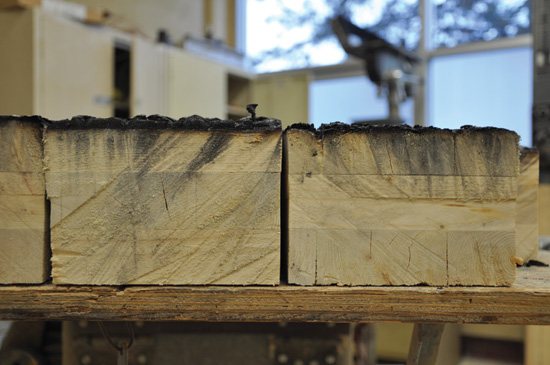Cross Laminated Timber
CLT and Fire Resistance
Structural integrity and fire containment capability of building assemblies can be assessed by conducting full-scale fire-resistance tests in accordance with ASTM E119 standard test methods. Fire resistance is defined as the ability of a material or their assemblies to prevent or retard the passage of excessive heat, hot gases or flames under conditions of fire. A fire-resistance rating is defined as the period of time a building element, component or assembly maintains the ability to confine a fire (separating function), and/or continues to perform a given structural function. More specifically, a standard fire-resistance test entails three failure/acceptance criteria:
- Structural resistance: the assembly must support the applied load for the duration of the test.
- Integrity: the assembly must prevent the passage of flame or gases hot enough to ignite a cotton pad.
- Insulation: the assembly must prevent the temperature rise on the unexposed surface from being greater than 325°F (180°C) at any location, or an average of 250°F (140°C) measured at a number of locations, above the initial temperature.
The time at which the assembly can no longer satisfy any one of these three criteria defines its fire-resistance rating.
AWC conducted a successful ASTM E119 fire resistance test on a CLT wall at NGC Testing Services in Buffalo, NY. The wall, consisting of a 5-ply CLT (approximately 6-7/8 inches thick), was covered on each side with a single layer of 5/8-inch Type X gypsum wallboard. The wall was loaded to the maximum load attainable by the NGC Testing Service equipment. The 10×10 foot test specimen lasted three hours, five minutes, and 57 seconds (03:05:57)—well beyond the two-hour goal.18
Industry has taken an analytical approach to CLT, rather than the route of prescriptive fire-rated assemblies. This is because CLT assemblies, and in particular floors, will most likely never be loaded to their full design capacities, but instead be designed based on serviceability (vibration and/or deflection). Therefore, it would be overdesigning to evaluate based on a prescriptive fire-rated assembly. This also allows more flexibility in wall and floor assembly designs. The approach taken was to test CLT under different load ratios, including full design loads, in order to validate the proposed calculation method(s). Fire resistance calculation methods will be included in the next version of the NDS and are explained in Chapter 8 of the U.S. CLT Handbook.
Results of full-scale fire tests show that CLT panels have the potential to provide excellent fire resistance comparable to the typical Type IV exterior wall assemblies of non-combustible construction. Due to the inherent nature of thick timber members to slowly char at a predictable rate, CLT panels can maintain significant structural capacity for an extended duration of time when exposed to fire.
Adhesives can also have an effect on fire performance, but standards exist to prevent that from playing a significant role in the overall product performance and to ensure appropriate adhesive performance under heat and fire. The ANSI/APA product standard established for CLT requires that, in the U.S., adhesives used in the manufacturing of CLT shall meet similar requirements as structural glued laminated timber used in dry service conditions (the equilibrium moisture content of wood is less than 16 percent). Also, adhesives shall be evaluated for heat performance.
The fire resistance calculation methodology outlined in Chapter 8 also accounts for altered performance characteristics of a laminated product like CLT. In addition to the fire-resistance calculation method of CLT assemblies, this chapter provides requirements related to fire safety in buildings, namely with regard to the types of construction prescribed in the IBC, fire-resistance requirements, connection detailing, interior finishes, through-penetrations and exterior walls.
 |
Thick timber members slowly char at a predictable rate, so CLT panels can maintain significant structural capacity for an extended duration of time when exposed to fire. Photo courtesy of FPInnovations |









